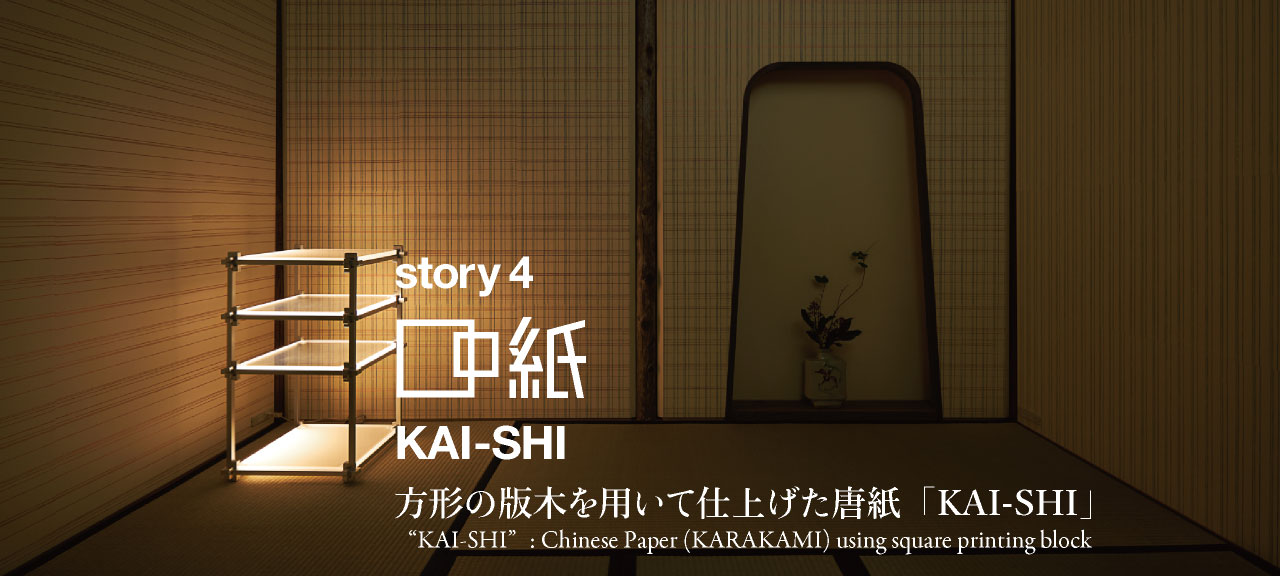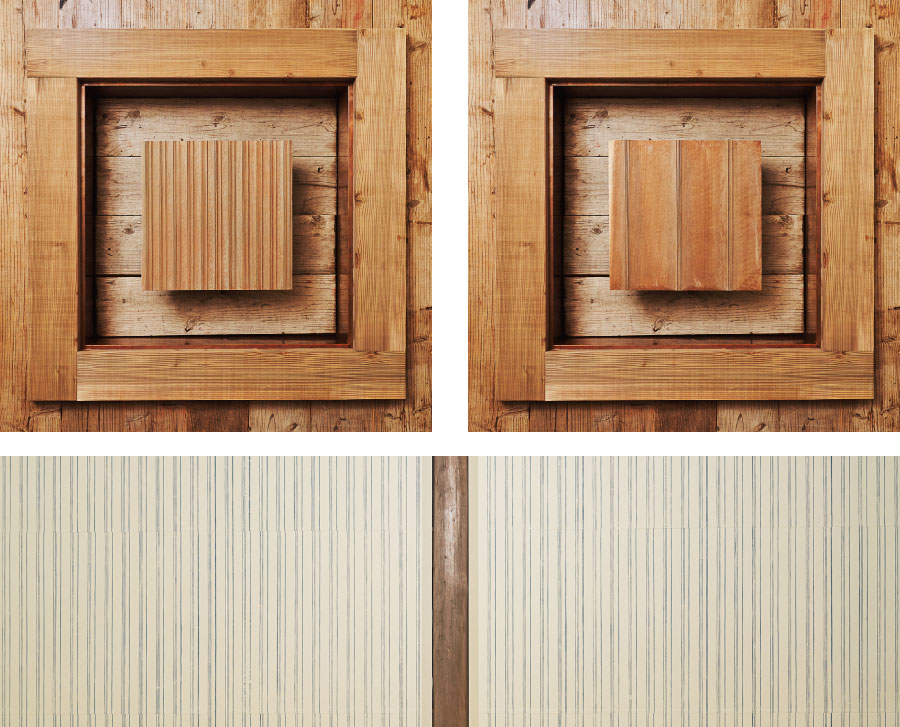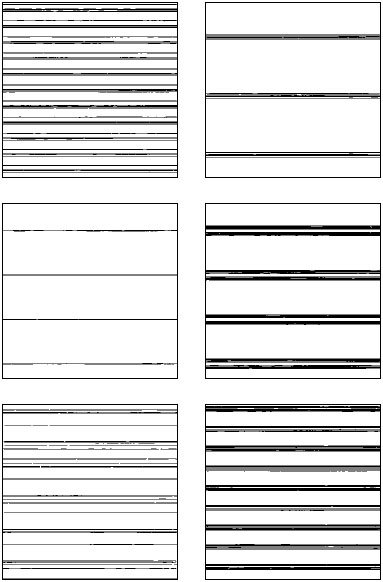

伝統的な和室から現代的な空間まで、インテリアから雑貨まで、唐紙(からかみ)はその部屋の目的や主人の好みに合わせた「室礼(しつらい)」のためのマテリアルとして、とても重要な役割を果たしてきました。松竹梅、鶴、亀などの祝文様や四季折々の草花、雲や波などの自然を形にした伝統文様がよく知られています。
唐紙は、奈良時代に中国(唐)から伝わった細工紙で、当時は和歌をしたためる美しい料紙として使われました。平安時代になると京都と江戸で国産の唐紙が作られるようになります。胡粉や雲母などを調合した顔料を版木(※)にのせ、一枚一枚、丁寧に版付けして和紙に擦る工程は、今も変わらず受け継がれています。
とくに斬新なデザインが次から次へと生まれたのは江戸時代でした。その拠点となったのが、本阿弥光悦が築き多くの工芸品を世に出した「光悦村」。光悦桐、光悦松、光悦菊、光悦大波などの意匠が生まれ、寺社や茶室の襖紙としてもよく使われるようになります。
KAIは、唐紙の版木の形や、文様を変えることで、古典的な唐紙の方法を大事にしながら、もっと多様な唐紙の使い方を生み出せるのではないかと考え、その一つの提案として─「KAI-SHI」をつくりました。
※版木は、朴木(ホオノキ)をもちいます。柔らかくて削りやすく、長い年月を経ても表面が滑らという特徴があります。
From traditional Japanese-style rooms to modern spaces, from interior design to miscellaneous goods, “karakami” paper has proved to be an extremely important material for shitsurai (tasteful room decorations on each occasion) according to the purpose of a room or the owner’s preferences. Auspicious patterns such as shochikubai (pine, bamboo and plum), tsuru (crane), and kame (turtle), and traditional motifs based on seasonal flowers, clouds, waves and other natural forms are well known.
Karakami craft paper was introduced from Tang China during the Nara Period. At the time, it was used as aesthetic writing paper for penning tanka poems. Entering the Heian Period, Japan started making its own karakami paper in Kyoto and Edo. The process of applying pigment made by blending gofun (Chinese white), mica and other materials to a printing block (*) and carefully pressing it onto washi paper one sheet at a time continues to be passed on today.
It was during the Edo Period especially that innovative designs appeared. “Koetsu mura,” a village which was founded by Honami Koetsu and was the birthplace of numerous craft products, became a center of karakami production. It produced designs such as Koetsu-giri (Koetsu paulownia), Koetsu-matsu (Koetsu pine), Koetsu-kiku (Koetsu chrysanthemum), and Koetsu-onami (Koetsu billow), and these came to be widely used in fusuma (sliding doors) paper in shrines, temples and tea ceremony rooms.
Through modifying the forms and patterns of the printing blocks, KAI believed it could create more diverse applications of karakami while cherishing the classical karakami method. One such proposal was “KAI-SHI”.
* Printing blocks are made from Japanese white bark magnolia, which has characteristics of being soft and easy to shave, and retaining surface smoothness for a long time.

唐紙の伝統的なつくりかたは、長方形のかたち(45cm×30cm)の版木をつかって、上下左右の柄を合わせながら一方向に擦り合わせていくというもの。いかにずらさずに版を押せるか、いかにつなぎ目がわからないようにできるかが勝負所です。その職人技が、まるで一枚の紙のようなシームレスな仕上がりを支えてきました。
「KAI-SHI」をつくるにあたり、唐紙の本質をそのまま大事にしつつ、縦糸と横糸で自在に絵柄をつくり出す「織物のような文様」を実現できないだろうかと職人さんとの対話を重ねました。そんななか、長年つかわれてきた長方形の版木を、方形(正方形:45cm×45cm)の形にするという大胆な挑戦に踏み切ることになりました。
方形の版木は、上下左右の配置の自由度を増やしました。また、版木をずらして押すことで、より風合いが出る「縞柄」や「格子柄」についても探求を続けました。そうして6つの「KAI-SHI」が出来上がり、無限の組み合わせを表現できるようになったのです。
In the traditional method of making karakami, a rectangular printing block (45cm x 30cm) is used to press vertical and horizontal patterns together in the same direction. The key point lies in concealing the joints by pressing the block without shifting. Such craftsmanship gives rise to a seamless finish like a single sheet of paper.
In making “KAI-SHI,” we held repeated talks with the artisans to explore the possibility of realizing “fabric-like patterns” with warp and weft designs while retaining the intrinsic essence of karakami. In doing so, we made the bold decision to replace traditionally used rectangular printing blocks with square-shaped blocks (45cm x 45cm).
Through adopting square printing blocks, we acquired greater freedom in designing vertical and horizontal arrangements. Also, through pressing the printing blocks while shifting them, we continued to explore possibilities for striped patterns and grid patterns offering deeper texture. In doing so, we created six “KAI-SHI” designs having the potential to realize unlimited combinations.

「KAI-SHI」をお披露目するにあたり、さまざまなディテールを自在に取り替えられる二階建茶室「KAI-RO」の壁を、鳥の子和紙から「KAI-SHI」に模様替えしました。鳥の子和紙の凛とした空気感もいいのですが、「KAI-SHI」がかもし出すモダンな品格はハッとするほど新鮮です。唐紙の職人さんは、紙に色をつけることを「色を置く」、「色をのせる」「紙を化粧する」と表現しますが、まさに「KAI-RO」の空間がお化粧されたようです。
話は変わりますが、韓国では、襖や障子や壁だけでなく、天井も床も「紙で包む」という文化があります。木の隙間を紙が埋め、オンドル(床暖)の入った床にも使用されます。また、障子も二重サッシのように両面張です。そのような文化がある韓国はもちろんのこと、アジアにおいても「KAI-SHI」の需要があるのではと考えています。日本が育んできた唐紙の文化を、日本の空間「KAI-RO」とともに発信していきたいです。
唐紙制作 かみ添 嘉戸 浩
In presenting “KAI-SHI,” we replaced torinoko Japanese paper with “KAI-SHI” on the walls of a two-story tea ceremony room “KAI-RO,” in which various details can be freely replaced. Although torinoko Japanese paper offers a distinguished ambience, the elegance and dignified atmosphere imparted by “KAI-SHI” is something else. Karakami artisans refer to the processing of coloring paper as “placing colors,” “adding colors” or “applying makeup to paper,” and the “KAI-RO” space certainly gives the impression of having undergone a cosmetic makeover.
Changing the subject, in South Korea, the culture of “wrapping in paper” is applied not only to fusuma sliding doors, shoji screens and walls, but also to ceilings and floors. Paper is used for filling gaps in timber and also in floors that contain “ondol” heaters. Shoji screens are also lined on both sides like double sashes. We believe there is a demand for “KAI-SHI” not only in South Korea, which has such culture, but also in rest of Asia. We intend to convey Japan’s karakami culture together with Japanese “KAI-RO” spaces.
Created by Kamisoe Ko Kado
語り手 : 三浦史朗 書き手 : 和泉佳奈子



| 版木サイズ | Printing block size |
|---|---|
| 45×45cm | 45×45cm |
| 文様6種 | Patterns: 6types |
| KAI-SHIの制作承ります。
版木を選んでオリジナルの文様作成も可能です。 お気軽にご相談ください。 例:襖紙、はがき など We undertake production of KAI-SHI. You can also select the printing block and create your own original designs. Feel free to consult us. Examples: Fusuma sliding door paper, postcards, etc. |
